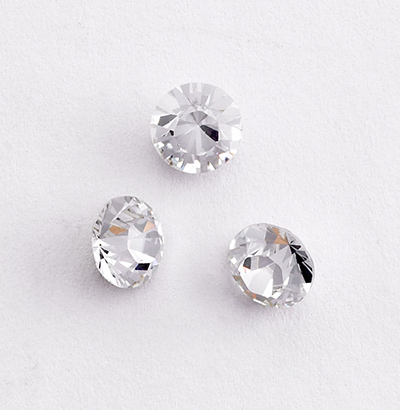What is a Rhinestone? A True Fairy Tale.
Posted by Rhinestones Unlimited on Aug 20th 2013
It’s actually a sweet little beginning:
Once upon a time, the banks of Europe’s Rhine River sparkled with thousands of rock crystal pebbles that gleamed in prismatic brilliance along the water’s edge. Highly prized and quite uncommon, these organic Rhine stones were gradually depleted, as wonderful things in nature too often are, and imitation pebbles were created to mimic the quartz crystals with the high lead content.
Though rhinestones are now made from a variety of materials (and recent developments keep advancing the standard; see Swarovski’s Advanced Crystal), lead crystal has traditionally been used in higher quality production for its light-refracting properties, with foil backings often applied as a mirror to create more intensity.
Lead crystal (usually referred to as simply “crystal”) is glass to which lead has been added. This changes the molecular structure of the material. The most valuable property of the addition of lead, at least to most of us, is the way light plays through the crystal: clear glass will simply allow light through, as a window will. Lead crystal breaks down the light into prisms, and hanging in a window, will cast the little rainbows on your wall (Roy G. Biv, word up! Side note: by contrast, Cubic Zirconia, which has a different molecular structure, was created to replicate the blazing white sparkle of zircon, a mineral used to make semi-precious gems). The addition of lead also adds density and makes the crystal softer and easier to cut, which is important for all of those tiny, precise facets. Not as necessary a fact in the rhinestone world, but lovely just the same, the added density is what causes the appealing peal of crystal stemware when struck or rubbed.
Lead crystal is now manufactured in several places, to certain specifications in lead content in order to qualify as true crystal. The process would make a great educational short on Mr. Rogers: because of the weight of the material, the glass blowing (if one was making crystal stemware, for instance) is not done by a single person, but by a team of very intricately coordinated artists (I tend to picture a Cirque du Soleil act here, but that’s just me); cuts are calculated to feature the prisms, and the flawless surface is created by lowering the cooled crystal into an acidic bath, much like an exfoliating alpha hydroxy treatment for your face. It’s also a waste free production- any imperfections and the crystal can be melted and reused, completely recycled. Recently, Swarovski has patented a new recipe for crystal that is lead-free, somehow gleaning all the light-breaking, density-making properties of the traditional composition with this newfangled concoction.
After hundreds of years of happiness brought on by the beauty that lead crystal has created, we are about to witness a new generation. And so we see that those little pebbles have spawned big things. Fortunately, the Rhine no longer has to be exploited for its lovely little beauties, as craftsmen’s innovations are constantly creating superior products that surpass the best. We will help you find the little pebble that’s right for you, and all will live in brilliance... …happily ever after.
The End.
-xo-
Jemm
Rhinestones Unlimited blog author Jemm Stone is a multifaceted girl navigating our sparkly world with on-point insights. Visit Blog.RhinestonesU.com to follow her thoughts as she highlights design trends, turns the spotlight on industry influencers and breaks down how-to tips like light through a crystal prism.

 Bulk
Bulk Crystal
Crystal Crystals
Crystals  Sales &
Sales &